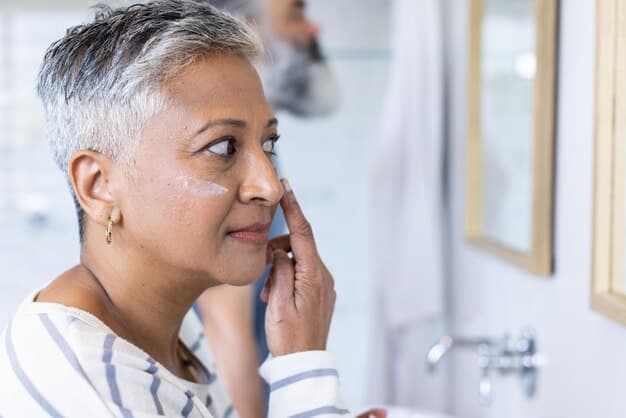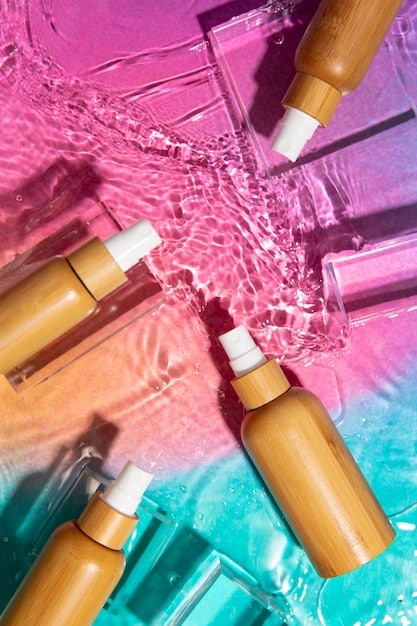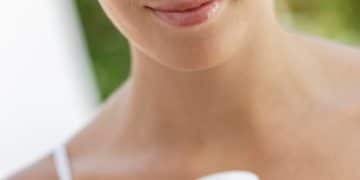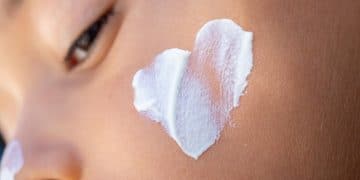The Best Skincare Routine for Aging Skin: A Comprehensive Guide

Anúncios
Achieving optimal skin health as we age demands a strategic, research-backed skincare routine focusing on hydration, collagen support, and protection to mitigate environmental damage and enhance natural radiance.
Navigating the complexities of skin changes as we age can feel daunting, but with the right approach, maintaining a healthy, vibrant complexion is entirely achievable. This comprehensive guide will explore **the best skincare routine for aging skin**, offering practical, evidence-based strategies to address common concerns like fine lines, wrinkles, loss of elasticity, and uneven skin tone.
Understanding the Aging Process and its Impact on Skin
The journey of aging is a natural and beautiful part of life, yet it brings with it undeniable changes to our skin. Understanding these alterations is the first crucial step in developing an effective skincare strategy. As years pass, our skin undergoes a series of transformations, impacting its structure, function, and appearance.
Aging skin often exhibits a decrease in collagen and elastin production, two vital proteins responsible for firmness and elasticity. This reduction leads to the formation of fine lines, wrinkles, and sagging. Additionally, the skin’s natural ability to retain moisture diminishes, resulting in dryness and a loss of plumpness. Environmental factors, particularly sun exposure, also accelerate these processes, causing hyperpigmentation, age spots, and further degradation of the skin’s matrix. A comprehensive routine considers these internal and external influences to provide targeted support.
Intrinsic and Extrinsic Aging Factors
Intrinsic aging is determined by our genetics, a naturally programmed process that affects all our organs, including the skin. Extrinsic aging, conversely, is influenced by external factors, many of which are within our control.
- Genetics: Our DNA dictates many aspects of our skin’s aging, including the rate of collagen breakdown and cell turnover.
- Sun Exposure: Ultraviolet (UV) radiation is one of the most significant contributors to premature aging, causing photodamage, wrinkles, and pigmentary changes.
- Pollution: Environmental pollutants generate free radicals that damage skin cells and accelerate the aging process.
Cellular Changes and Their Consequences
At a microscopic level, aging skin experiences reduced cell regeneration, a slowdown in the natural shedding of dead skin cells. This leads to a duller complexion and less efficient absorption of skincare products. The barrier function of the skin, crucial for protecting against irritants and retaining moisture, also weakens with age, making the skin more susceptible to dryness and sensitivity. Understanding these foundational changes allows for a more informed selection of ingredients and practices designed to counteract their effects and support skin health.
Navigating the intrinsic and extrinsic factors that contribute to skin aging is essential for crafting a routine that truly works. By addressing both the natural biological changes and the environmental stressors, we can better support our skin’s resilience. This holistic view prepares the skin to respond more effectively to targeted treatments, paving the way for a healthier, more youthful appearance over time.
Pillars of an Effective Skincare Routine for Mature Skin
Building an effective skincare routine for mature skin is not about quick fixes but about consistent, targeted care. It involves a multi-faceted approach that prioritizes protection, repair, and nourishment. The key is to select ingredients and practices that actively support the skin’s natural functions, helping to mitigate the visible signs of aging while promoting overall skin health. This foundation ensures that each step works synergistically to deliver maximum benefits.
Cleansing: Gentle and Thorough
Cleansing is the first and most fundamental step in any skincare routine, especially for mature skin. Harsh cleansers can strip the skin of its natural oils, exacerbating dryness and compromising the skin barrier.
- Cream or Oil-Based Cleansers: Opt for rich, hydrating cleansers that gently remove impurities without causing tightness or irritation.
- Avoid Hot Water: Use lukewarm water to prevent further drying of the skin.
- Double Cleansing: Consider a double cleanse in the evening, starting with an oil-based cleanser to dissolve makeup and sunscreen, followed by a gentle, hydrating cream cleanser.
A gentle yet effective cleansing routine sets the stage for better absorption of subsequent products. It ensures that the skin is clean and prepped, allowing active ingredients to penetrate and perform their functions optimally without beinghindered by surface debris or residue.
Targeted Treatments: Serums and Actives
This is where the real work happens in an anti-aging routine. Serums are concentrated formulations designed to deliver potent active ingredients deep into the skin. Choosing the right serums can significantly impact the appearance of fine lines, wrinkles, and overall skin texture.
The selection of active ingredients should be tailored to individual concerns, whether it’s collagen stimulation, hyperpigmentation correction, or intense hydration. Consistent application is crucial for these treatments to yield noticeable results over time.
Moisturizing: Replenish and Protect
Moisturizing is non-negotiable for mature skin, providing essential hydration and helping to fortify the skin’s barrier function. A good moisturizer seals in the active ingredients from serums and prevents trans-epidermal water loss.
Look for moisturizers rich in emollients, humectants, and occlusives to provide comprehensive hydration and protection. Ingredients like hyaluronic acid, ceramides, and glycerin are excellent choices. Applying moisturizer to slightly damp skin can also enhance absorption and effectiveness. This critical step ensures that the skin remains supple and resilient throughout the day and overnight.
Sun Protection: The Ultimate Anti-Aging Step
No anti-aging routine is complete without daily sun protection. UV radiation is a primary cause of premature aging, leading to wrinkles, age spots, and loss of elasticity. Broad-spectrum SPF 30 or higher is essential.
Even on cloudy days or indoors near windows, UV rays can still penetrate and damage the skin. Consistent and generous application of sunscreen is the single most effective measure to prevent further photodamage and support the skin’s long-term health. Think of sunscreen as your daily insurance policy against future aging concerns.

Key Ingredients to Look for in Skincare for Aging Skin
Selecting products with the right ingredients is paramount in an effective anti-aging skincare regimen. Not all ingredients are created equal, and understanding their individual benefits allows for a more targeted and impactful approach. The power of these components lies in their ability to address specific concerns associated with aging, from collagen degradation to oxidative stress. Prioritizing ingredients with proven efficacy sets the stage for visible improvements and sustained skin health.
Retinoids (Retinol, Retinaldehyde, Tretinoin)
Retinoids are arguably the gold standard in anti-aging skincare. Derived from Vitamin A, they stimulate collagen production, accelerate cell turnover, and reduce the appearance of fine lines, wrinkles, and hyperpigmentation.
Starting with a lower concentration and gradually increasing usage is advised to allow the skin to adapt, minimizing potential irritation. Consistent, long-term use yields significant improvements in skin texture and overall radiance. The transformative effects of retinoids make them a non-negotiable staple for many.
Hyaluronic Acid (HA)
Hyaluronic acid is a powerful humectant, meaning it draws moisture from the air into the skin. It can hold up to 1,000 times its weight in water, making it an excellent ingredient for hydrating and plumping the skin.
HA helps reduce the appearance of fine lines by increasing skin hydration, leading to a smoother and more supple complexion. It’s gentle and suitable for most skin types, making it a versatile addition to any anti-aging routine. This ingredient provides an instant boost of moisture, contributing to a refreshed look.
Vitamin C (Ascorbic Acid)
Vitamin C is a potent antioxidant that protects the skin from free radical damage caused by environmental aggressors like pollution and UV radiation. It also plays a crucial role in collagen synthesis, brightening the complexion, and reducing the appearance of dark spots.
Using a stable form of Vitamin C in a serum can significantly enhance skin’s luminosity and evenness over time. Its multi-faceted benefits make it an essential daily defense and repair ingredient. Incorporating Vitamin C helps to safeguard the skin against daily assaults, preserving its youthful vitality.
Peptides
Peptides are short chains of amino acids, the building blocks of proteins, including collagen and elastin. When applied topically, they can signal the skin to produce more collagen, improve elasticity, and reduce the look of wrinkles.
Different types of peptides offer various benefits, from stimulating collagen to promoting wound healing. They are generally well-tolerated and can be a great addition for those seeking to boost their skin’s firmness and resilience. Peptides offer a sophisticated approach to stimulating natural skin regeneration.
AHAs and BHAs (Alpha Hydroxy Acids and Beta Hydroxy Acids)
These chemical exfoliants help to remove dead skin cells, promoting cell turnover and revealing brighter, smoother skin. AHAs like glycolic acid and lactic acid are water-soluble and excellent for improving skin texture and tone.
BHAs, such as salicylic acid, are oil-soluble, making them effective for decongesting pores and treating breakouts, even in mature skin. Regular, gentle exfoliation helps prevent dullness and allows other active ingredients to penetrate more effectively. Thoughtful use of these acids can revitalize the skin’s surface, enhancing its natural glow.
Niacinamide (Vitamin B3)
Niacinamide is a versatile ingredient that offers a multitude of benefits for aging skin. It helps improve skin elasticity, reduce the appearance of fine lines and wrinkles, and even out skin tone.
Furthermore, niacinamide strengthens the skin’s barrier function, reduces redness and inflammation, and minimizes the appearance of pores. Its anti-inflammatory properties make it suitable for sensitive skin types, providing gentle yet effective support. This ingredient is a true multi-tasker, addressing various concerns simultaneously.
Building Your Morning Skincare Routine for Aging Skin
The morning skincare routine for aging skin serves two primary purposes: protecting the skin from environmental stressors encountered throughout the day and preparing it for makeup application, if desired. Each step is designed to provide a layer of defense and nourishment, ensuring the skin remains resilient and radiant from dawn till dusk. Consistency in this routine is key to maximizing its protective and corrective benefits over time.
Step 1: Gentle Cleansing (Optional)
While some prefer a full cleanse in the morning, mature skin often benefits from a lighter approach. If your skin feels clean from the night before, a splash of lukewarm water might suffice. If you do cleanse, opt for a very gentle, hydrating cleanser to avoid stripping the skin.
The goal is to gently refresh the skin without disturbing its natural moisture balance, preparing it for the layers of treatment to follow. This minimal approach helps preserve the skin’s delicate barrier.
Step 2: Antioxidant Serum (Vitamin C)
Apply a Vitamin C serum after cleansing (or rinsing). As a powerful antioxidant, Vitamin C neutralizes free radicals generated by UV radiation and pollution, preventing cellular damage that contributes to aging.
It also brightens the complexion and supports collagen production. A stable, well-formulated Vitamin C serum is a cornerstone of daily anti-aging protection. This step is your skin’s shield against the day’s environmental assaults.
Step 3: Eye Cream
The delicate skin around the eyes is often the first to show signs of aging. Apply a hydrating eye cream with ingredients like peptides, hyaluronic acid, or retinoids (if tolerated) to gently address fine lines, dark circles, and puffiness.
Use your ring finger to dab the product gently around the orbital bone. Regular application helps maintain the elasticity and hydration in this fragile area. An effective eye cream can significantly refresh the overall appearance of your face.
Step 4: Moisturizer
Follow with a nourishing moisturizer appropriate for your skin type. This step locks in the serums, provides essential hydration, and helps to reinforce the skin’s barrier function.
Look for formulas rich in ceramides, hyaluronic acid, or other emollients to keep the skin supple and protected throughout the day. A well-hydrated canvas is more resilient and appears smoother.
Step 5: Sunscreen (Broad-Spectrum SPF 30+)
This is the most critical step in your morning routine. Apply a broad-spectrum sunscreen with an SPF of 30 or higher generously to all exposed skin, including your face, neck, and décolletage.
Even on cloudy days, UV rays are present and contribute to skin aging. Reapply throughout the day if you are outdoors for extended periods or sweating. Sunscreen is your ultimate defense against premature aging and skin damage.
Building Your Evening Skincare Routine for Aging Skin
The evening skincare routine for aging skin shifts focus from daily protection to repair and regeneration. Overnight is when the skin’s natural renewal processes are most active, making it the ideal time to apply potent active ingredients that support cellular repair and collagen synthesis. This routine aims to undo daily damage, nourish deeply, and prepare the skin for another day.
Step 1: Double Cleansing
Start by double cleansing to thoroughly remove makeup, sunscreen, and environmental pollutants accumulated throughout the day. Begin with an oil-based cleanser, which effectively dissolves oil-soluble impurities without stripping the skin.
Follow with a gentle, hydrating cream or gel cleanser to remove any remaining residue and refresh the skin. This dual approach ensures a clean slate, allowing subsequent products to penetrate effectively.
Step 2: Targeted Treatment (Retinoid)
After cleansing, apply your targeted treatment. For aging skin, a retinoid (like retinol or tretinoin) is highly recommended. Retinoids stimulate collagen production, accelerate cell turnover, and reduce the appearance of wrinkles and fine lines.
Start with a low concentration a few nights a week and gradually increase frequency as your skin builds tolerance to minimize irritation. This step is a powerful agent for long-term skin transformation.
Step 3: Hydrating Serum (Hyaluronic Acid, Peptides, or Niacinamide)
Follow your retinoid with a hydrating serum. If using a retinoid, an intensely hydrating serum with hyaluronic acid can help counter potential dryness. Alternatively, serums with peptides or niacinamide can also provide additional benefits, such as improving elasticity or reducing redness.
Applying a hydrating layer helps to nourish the skin barrier and ensure optimal comfort. This step provides essential moisture and allows effective layering of active ingredients.
Step 4: Eye Cream
Pat an eye cream gently around the orbital bone. In the evening, an eye cream formulated with reparative ingredients like peptides, ceramides, or a gentle retinoid can provide intensive care for fine lines and elasticity around the eyes.
This focused treatment helps to fortify the delicate skin in this area, which is highly susceptible to visible signs of aging. Consistency here can lead to notable improvements in eye contour.
Step 5: Rich Night Cream or Facial Oil
Conclude your evening routine with a nourishing night cream or facial oil. These products are typically richer than daytime moisturizers and designed to provide intensive hydration and barrier support while you sleep.
Look for ingredients like ceramides, fatty acids, and antioxidants to deeply moisturize and help the skin recover overnight. This final layer seals in all the previous treatments, ensuring maximum benefit and wake up to softer, more supple skin.

Lifestyle Factors Supporting Healthy Aging Skin
While a dedicated skincare routine is essential, a holistic approach to healthy aging skin extends beyond topical products. Lifestyle choices play a significant role in influencing skin health, either enhancing or undermining the efforts made with creams and serums. Embracing these supportive habits creates a synergistic effect, amplifying the benefits of your skincare routine and promoting overall well-being. Focusing on these elements allows the skin to thrive from within, reflecting true vitality.
Nutrition: Feed Your Skin from Within
What you eat directly impacts your skin’s health and appearance. A diet rich in antioxidants, healthy fats, and lean proteins can significantly benefit aging skin.
- Antioxidants: Berries, leafy greens, and colorful vegetables help combat free radical damage.
- Healthy Fats: Avocados, nuts, seeds, and fatty fish (like salmon) provide essential fatty acids that support skin barrier function and hydration.
- Lean Proteins: Found in chicken, fish, beans, and lentils, these provide the amino acids necessary for collagen and elastin production.
Adequate hydration through water intake is also crucial for maintaining skin plumpness and elasticity. Avoiding excessive sugar intake, which can contribute to advanced glycation end-products (AGEs) that damage collagen, is also advisable. A balanced diet is truly the foundation for glowing skin.
Hydration: The Internal Moisturizer
Drinking adequate water throughout the day is fundamental to maintaining skin hydration from the inside out. When the body is dehydrated, the skin can appear dull, dry, and more prone to showing fine lines.
Aim to drink at least eight glasses of water daily, and even more if you are physically active or in hot climates. Herbal teas and water-rich foods like fruits and vegetables also contribute to overall hydration. This simple habit can significantly improve your skin’s texture and resilience.
Sleep: The Beauty Sleep Factor
Quality sleep is a powerful regenerative process for the entire body, including the skin. During sleep, the skin repairs itself, produces new collagen, and recovers from daily environmental stressors.
Lack of sleep can lead to increased cortisol levels, which can break down collagen and exacerbate inflammation, contributing to premature aging. Aim for 7-9 hours of uninterrupted sleep each night to allow your skin to properly restore and rejuvenate. Prioritizing rest is a non-negotiable step for youthful radiance.
Stress Management: Mind-Body Connection
Chronic stress can have a detrimental effect on skin health. When stressed, the body releases hormones like cortisol, which can trigger inflammation, impair barrier function, and accelerate collagen breakdown.
Practices such as meditation, yoga, mindfulness, and spending time in nature can help manage stress levels. Integrating these activities into your daily routine can promote a calmer physiological state, which in turn benefits your skin. A relaxed mind often translates to a more radiant complexion.
Regular Exercise: Boost Circulation and Radiance
Engaging in regular physical activity improves blood circulation, which delivers oxygen and nutrients to skin cells and carries away waste products. This enhanced circulation contributes to a healthier, more vibrant complexion.
Exercise can also help reduce stress and improve sleep quality, indirectly benefiting skin health. Aim for at least 30 minutes of moderate exercise most days of the week. The glow after a good workout is a testament to exercise’s positive impact on your skin.
Professional Treatments to Complement Your Routine
While a consistent at-home skincare routine forms the bedrock of healthy aging skin, professional treatments can offer targeted solutions and amplify results. These procedures, performed by dermatologists or licensed estheticians, can address specific concerns that topical products might only partially improve, such as deep wrinkles, significant hyperpigmentation, or severe loss of elasticity. Integrating professional care into your regimen thoughtfully can bridge gaps and accelerate progress toward your skin goals.
Chemical Peels
Chemical peels involve applying a chemical solution to the skin to exfoliate the top layers, revealing smoother, more even-toned skin underneath. They can address fine lines, sun damage, hyperpigmentation, and improve overall skin texture.
Different strengths of peels are available, from superficial to deep, tailored to individual concerns and skin types. A series of treatments is often recommended for optimal results, providing a refreshed, more youthful appearance.
Laser Therapies
Laser treatments use focused light energy to address various skin concerns. Fractional lasers, for example, create microscopic channels in the skin to stimulate collagen production, improving texture, tone, and reducing wrinkles.
IPL (Intense Pulsed Light) targets redness and pigmentation. Laser treatments can significantly improve the signs of aging, but often require downtime and multiple sessions. Consulting with a professional is essential to determine the most suitable laser for your skin.
Microneedling
Microneedling involves using a device with tiny needles to create controlled micro-injuries in the skin. This stimulates the body’s natural wound-healing process, leading to increased collagen and elastin production.
It can improve the appearance of fine lines, wrinkles, scars, and overall skin texture and firmness. While relatively minimally invasive, a series of treatments is typically recommended for the best outcomes.
Dermal Fillers and Neuromodulators (Botox)
For deeper wrinkles and volume loss, injectables like dermal fillers and neuromodulators can provide significant improvements. Dermal fillers, often made of hyaluronic acid, restore lost volume, plump up lines, and enhance facial contours.
Neuromodulators like Botox temporarily relax muscles that cause dynamic wrinkles (e.g., frown lines, crow’s feet). These procedures require a skilled and experienced practitioner and offer a more immediate, though temporary, solution to visible signs of aging.
Regular Facial Treatments
While not as intensive as peels or lasers, regular professional facials can provide deep cleansing, exfoliation, and hydration that complements your home routine. A skilled esthetician can also assess your skin and offer personalized product recommendations.
Facials can improve circulation, promote relaxation, and maintain overall skin health. They serve as an excellent adjunctive therapy to a comprehensive anti-aging plan. Regularly scheduled facials provide a beneficial boost to skin vitality and appearance.
| Key Point | Brief Description |
|---|---|
| 🧴 Gentle Cleansing | Removes impurities without stripping skin, preserving natural oils. Essential for product absorption. |
| ☀️ Daily SPF | Crucial for preventing photodamage and premature aging. Non-negotiable. |
| 🧬 Active Ingredients | Incorporate retinoids, Vitamin C, and hyaluronic acid for collagen, brightness, and hydration. |
| 🍎 Holistic Approach | Support skin health with nutrition, hydration, quality sleep, and stress management. |
Frequently Asked Questions about Skincare for Aging Skin
While visible signs of aging typically appear in the late 20s to early 30s, “anti-aging” skincare is more about prevention than correction. Starting preventive measures, especially daily sunscreen and antioxidant use, in your 20s can significantly slow down the appearance of fine lines and sun damage. It’s never too late, however, to begin a targeted routine.
For many with aging skin, gradually building up to nightly retinol use is the goal for optimal results. However, it’s crucial to start slowly, perhaps 2-3 times a week, to allow your skin to acclimatize and avoid irritation. If dryness or sensitivity occurs, reduce frequency or try a lower concentration. Listen to your skin’s unique needs.
Sunscreen is arguably the single most important product for aging skin. UV radiation is the primary cause of premature aging, leading to wrinkles, dark spots, and loss of elasticity. Daily broad-spectrum SPF 30 or higher, even on cloudy days, is essential to prevent further damage and protect your skin’s youthful appearance and health.
To address lost elasticity in aging skin, look for ingredients that stimulate collagen and elastin production. Top contenders include retinoids (retinol, tretinoin), peptides, and growth factors. Consistent use of these actives helps to gradually improve skin firmness and bounce by strengthening its underlying structure, leading to a more supple texture over time.
Yes, adjusting your skincare routine seasonally can be beneficial for aging skin. In colder, drier months, you might need richer moisturizers and more hydrating serums to combat environmental dryness. During warmer, more humid periods, lighter textures might be preferred. Always maintain your core active ingredients and daily SPF, but adapt supportive products as needed.
Conclusion
Caring for aging skin is a journey that blends science with self-care, acknowledging the natural process of time while actively supporting skin health. By establishing a consistent routine grounded in gentle cleansing, potent active ingredients, diligent moisturizing, and unwavering sun protection, you empower your skin to retain its resilience and radiance. Remember that lifestyle choices—nourishment, hydration, sleep, and stress management—are powerful allies in this endeavor, complementing your topical efforts. Ultimately, embracing a holistic approach to skin care allows for a more vibrant complexion that truly reflects a well-lived life.





